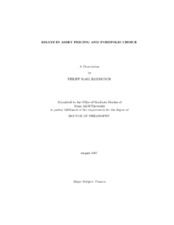| dc.description.abstract | In the first essay, I decompose inflation risk into (i) a part that is correlated with real returns on the market portfolio and factors that determine investor’s preferences and investment opportunities and (ii) a residual part. I show that only the first part earns a risk premium. All nominal Treasury bonds, including the nominal money-market account, are equally exposed to the residual part except inflation-protected Treasury bonds, which provide a means to hedge it. Every investor should put 100% of his wealth in the market portfolio and inflation-protected Treasury bonds and hold a zero-investment portfolio of nominal Treasury bonds and the nominal money market account.
In the second essay, I solve the dynamic asset allocation problem of finite lived, constant relative risk averse investors who face inflation risk and can invest in cash, nominal bonds, equity, and inflation-protected bonds when the investment opportunityset is determined by the expected inflation rate. I estimate the model with nominal bond, inflation, and stock market data and show that if expected inflation increases, then investors should substitute inflation-protected bonds for stocks and they should borrow cash to buy long-term nominal bonds.
In the lastessay, I discuss how heterogeneity in preferences among investors withexternal non-addictive habit forming preferences affects the equilibrium nominal term structure of interest rates in a pure continuous time exchange economy and complete securities markets. Aggregate real consumption growth and inflation are exogenously specified and contain stochastic components thataffect their means andvolatilities. There are two classes of investors who have external habit forming preferences and different localcurvatures oftheir utility functions. The effects of time varying risk aversion and different inflation regimes on the nominal short rate and the nominal market price of risk are explored, and simple formulas for nominal bonds, real bonds, and inflation risk premia that can be numerically evaluated using Monte Carlo simulation techniques are provided. | en |


